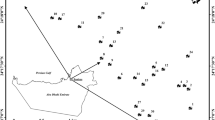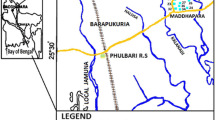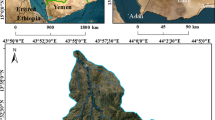Abstract
Water pipes are considered to be one of responsible sources for the water pollution. Among these sources of water supply, the water pipes are the only source of carrying out fresh or processed water into lakes, ponds and streams etc. In Pakistan, knowledge on the condition of water pipes is scarce as deterioration of water pipes are hardly inspected due to high cost. The aim of the current research was to examine the quality of water pipelines of eight districts of South-Punjab, namely, Mianwali, Khushab, Layyah, Bhakkar, Dera Ghazi Khan, Muzaffargarh, Rajanpur and Rahim Yar Khan. Selected sampling stations were analyzed for physio-chemical parameters such as pH, Total Dissolve Solids (TDS), Sulfate (SO4), Chlorine (Cl), Calcium (Ca), Magnesium (Mg), Hardness, Nitrate (NO3), Fluoride (F) and Iron (Fe). The data pertaining water monitoring contain different parameters and seem difficult work for the interpretation of water quality by managing different parameters separately. For this purpose, National Sanitation Foundation Water Quality Index (NSF-WQI) was determined to communicate the quality of water in a simple form. Besides this, groups comprising of similar sampling sites based on water quality characteristics were identified using unsupervised technique. Factor Analysis (FA) has been performed for extracting the latent pollution sources that may cause the more variance in large and complex data. The calculated values of WQI from 1600 sampling stations ranging from 20.73 to 223.74 are divided into five groups; Excellent to Unsuitable class of waters with the average value 62.09 described as good limit for drinking water. Further sampling stations are divided into five optimal clusters selected with suitable k value obtained from Silhouette coefficient. Results of k-means clustering are also verified with natural groups made by WQI. Analysis of multivariate techniques showed several factors to be responsible for the water quality deterioration. It is found out from the FA that three latent factors such as organic pollution, agriculture run-off and urban land use caused 83.30 % of the total variation. Hence, water quality management and control of these latent factors are strongly recommended.


Similar content being viewed by others
References
APEC 2006 http://www.freedrinkingwater.com/water-education/water-health.htm
Akbar A, Sitara U, Khan SA, Muhammad N, Khan MI, Khan YH, Kakar SUR (2013) Drinking water quality and risk of waterborne diseases in the rural mountainous area of Azad Kashmir Pakistan. International Journal of Biosciences 3(12):245–251
Ayeni A, Soneye A (2013) Interpretation of surface water quality using principal components analysis and cluster analysis. Journal of Geography and Regional Planning 6(4):132–141
Azrina M, Yap C, Ismail AR, Ismail A, Tan S (2006) Anthropogenic impacts on the distribution and biodiversity of benthic macro invertebrates and water quality of the langat river, peninsular Malaysia. Ecotoxicol Environ Saf 64(3):337–347
Cude CG (2001) Oregon water quality index a tool for evaluating water quality management effectiveness.
Emad AMS, Ahmed MT, Eethar MAO (2012) Assessment of water quality of euphrates river using cluster analysis. J Environ Prot 3(12):1269
Garriga RG, de Palencia AJF, Foguet AP (2015) Improved monitoring framework for local planning in the water, sanitation and hygiene sector: From data to decision-making. Sci Total Environ 526:204–214
Hashmi I, Farooq S, Qaiser S (2009) Chlorination and water quality monitoring within a public drinking water supply in Rawalpindi cantt (westridge and tench) area, Pakistan. Environ Monit Assess 158(1–4):393–403
Jain AK (2010) Data clustering: 50 years beyond k-means. Pattern Recogn Lett 31(8):651–666
Khan AA, Paterson R, Khan H (2004) Modification and application of the Canadian council of ministers of the environment water quality index(ccme wqi) for the communication of drinking water quality data in Newfoundland and Labrador. Water Qual Res J Can 39(3):285–293
Khan RA, Juahir H, Yusoff MK, Zain SM, TI TH (2012) Using principal component scores and artificial neural networks in predicting water quality index. INTECH Open Access Publisher 271(1–4):283–300
Lenore SC, Arnold EG, Andrew DE (1998) Standard methods for the examination of water and wastewater. American Public Health Association. American Water Works Association and World Environment Federation. 20th Edition, Washington DC.
Liou SM, Lo SL, Wang SH (2004) A generalized water quality index for Taiwan. Environ Monit Assess 96(1–3):35–52
Mehmood S, Ahmad A, Ahmed A, Khalid N, Javed T (2013) Drinking water quality in capital city of Pakistan. Sci Rep 2:637. doi:10.4172/scientificreports.637
R Core Team (2015) R: a language and environment for statistical computing. R foundation for statistical computing, Vienna, Austria. URL https://www.R-project.org/
Ramakrishnaiah C, Sadashivaiah C, Ranganna G (2009) Assessment of water quality index for the groundwater in tumkur taluk, Karnataka state, India. Journal of Chemistry 6(2):523–530
Saeedi M, Abessi O, Sharifi F, Meraji H (2010) Development of groundwater quality index. Environ Monit Assess 163(1–4):327–335
Said A, Stevens DK, Sehlke G (2004) An innovative index for evaluating water quality in streams. Environ Manag 34(3):406–414
Shi W, Zeng W (2014) Application of k-means clustering to environmental risk zoning of the chemical industrial area. Frontiers of Environmental Science & Engineering 8(1):117–127
Shihab AS, Baqi YTA (2010) Multivariate analysis of ground water quality of makhmor plain/North Iraq. Damascus University Journal 26(1):19–26
Singovszka E, Balintova M (2012) Application factor analysis for the evaluation surface water and sediment quality. Chem Eng Trans 26:183–188
Udom GJ, Nwankwoala HO, Daniel TE (2016) Determination of water quality index of Shallow Quaternary Aquifer Systems in OGBIA, BAYELSA State, Nigeria. British Journal of Earth Sciences Research 4(1):23–37
Veljkovic N, Lekic D, Jovičic M (2008) Case study of water management processes: Serbian water quality index. In XXIVth Conference of the Danubian Countries, pages 2–4
Acknowledgments
The authors are grateful to Pakistan Council of Research in Water Resources Regional office, Lahore for providing data to meet the objectives of the study. The authors are also thankful to the Deanship of Scientific Research, King Saud University Riyadh for funding the work through the research Group project No RGPVPP-210. Last but not least the authors are thankful to the reviewers and editor for their valuable comments.
Author information
Authors and Affiliations
Corresponding author
Rights and permissions
About this article
Cite this article
Nazir, H.M., Hussain, I., Zafar, M.I. et al. Classification of Drinking Water Quality Index and Identification of Significant Factors. Water Resour Manage 30, 4233–4246 (2016). https://doi.org/10.1007/s11269-016-1417-4
Received:
Accepted:
Published:
Issue Date:
DOI: https://doi.org/10.1007/s11269-016-1417-4




